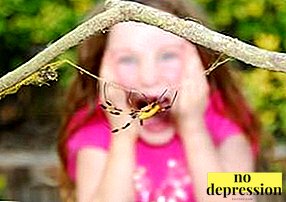There are many different phobias, that is, fear of any creature or phenomenon. What is arachnophobia?
it the most common type of zoophobia - fear of arachnids. Causes, symptoms and methods of struggle will discuss in this article.
General concept
 Fear of spiders is called arachnophobia. This phobia has gained quite a wide influence and therefore it has been identified in separate species.
Fear of spiders is called arachnophobia. This phobia has gained quite a wide influence and therefore it has been identified in separate species.
Half of the world's population is afraid of arthropods.
In most cases, women are prone to this, and only one tenth of men. Arachnophobes are not only afraid of living spiders, but also their images. Some arachnophobes cannot enter a room where there may be arachnids, and the view of the cobweb terrifies them.
This fear becomes a problem and prevents to lead a normal diverse life: a person can not go on nature, afraid to sit in the gazebo or grass, go into the old room. Scientists are studying the causes and developing methods of struggle, as this type of phobia acquires a global scale.
Arachnophobia is expressed in disgust and fear of spiders, one of their kind drives a person into a stupor, goose bumps run down the skin. Often, along with fear come the fear of death from the bite of a spider.
This feeling can be so strong and uncontrollable, that a person may increase pressure, heart palpitations up to loss of consciousness.
Such an attitude to arthropods has a geographical factor of influence. For example, arachnophobia is very common in Europe, while Asian countries are not afraid of spiders and even feed on them, considering them to be a delicacy.
Who are arachnophobes? Why are people afraid of spiders? Assumptions in this video:
Causes
Most people can’t answer exactly the question why they are afraid of spiders and from when it started. There are several possible causes of this phobia:
 Often the fear of spiders has hereditary factor. If the parents of a child since childhood show him an example of the fear of arthropods, they constantly talk about danger, the child from an early age develops a similar attitude.
Often the fear of spiders has hereditary factor. If the parents of a child since childhood show him an example of the fear of arthropods, they constantly talk about danger, the child from an early age develops a similar attitude.- Parents with weakened nervous system and a large anxiety factor, children are more likely to suffer from various phobias.
- Fear of death from the bite of a poisonous spider. Mostly this factor is influenced by modern horror films, in which a person dies from bites of arthropods.
- Why see spiders? Unpleasant meeting with the spider in childhood or his bite.
- A panic attack can cause the sudden the appearance of the spider near the human body, as well as its quick moving.
- The cause of arachnophobia may have regional component: in areas where a large number of arthropods prevails, self-preservation instinct works in humans. For city dwellers, this fear is considered a pathology.
How dangerous are arachnids?
Scientists claim that arachnids - one of the oldest inhabitants on the planet, which in the process of evolution practically did not change either in size or externally.
Most of their representatives are poisonous to animals, and their poison does not affect humans. Insects that are truly poisonous and dangerous to humans live in deserts and jungles.
 In Russia, dangerous spiders live mainly in the south, in most cases they are listed in Red book.
In Russia, dangerous spiders live mainly in the south, in most cases they are listed in Red book.
Usually they do not show aggression towards a person, they attack only in the case of a mortal danger for them.
For example, a spider called Karakurt - the most dangerous in Russia: 6% of those bitten die from its poison.
South Russian Tarantula occurs quite often. The bite is painful, but not fatal, causes fever, allergic reaction and swelling. Bite silverfish comparable to a bee sting.
Yes, and it is difficult to meet him, as the habitat is a quagmire. Krestovik very small, bite hard to notice. It can bite only in the place where there is thin skin. Soreness at the bite of an Eresus spider disappears within a few days.
In fact, the representatives of this order of insects are not as dangerous as is commonly believed. A big role is played by their unpleasant intimidating appearance.
Some amazing facts about spiders in this video:
Symptoms and signs

Need to be able to share hostility and pathological fear.
Dislike manifested in aversion to the creature. With arachnophobia panic attack occurs even from the picture.
In the absence of a stimulus (provocateur) a phobia manifests itself in the form of anxiety, fear of meeting, a person preparing morally to collide with arthropods at any time.
With direct contact, a number of physiological changes occur. Symptoms following:
- heart palpitations;
- cold sweat;
- goosebumps;
- dizziness;
- trembling through the body;
- nausea;
- in the most severe cases, bladder emptying, difficulty breathing are possible.
Fear of arachnids can greatly affect on quality of life and health. During panic attacks, a person cannot control himself, the work of the nervous and vegetative systems is disturbed.
In this condition, there may be serious consequences, such as stroke, heart attack. In this case, you have to turn to the help of a psychotherapist and medicines.
Treatment methods
I'm afraid of spiders: how to get rid of arachnophobia? In most cases, the person can not heal himself. The help of the psychotherapist and medicines is necessary.
 Medications. Often the accompanying treatment is medication as a symptomatic treatment. Prescribed antidepressants, drugs that stimulate the blood supply to the brain, vitamins, medications to relieve anxiety.
Medications. Often the accompanying treatment is medication as a symptomatic treatment. Prescribed antidepressants, drugs that stimulate the blood supply to the brain, vitamins, medications to relieve anxiety.- Psychotherapy. It consists in a conversation in which the doctor and the patient discuss the behavior of a person during a panic attack. The doctor helps the patient to understand how not to lose self-control during a meeting with an object of dislike, to get rid of negative attitudes, to reduce the significance of fear.
- Contact with an object or behavioral therapy. A person learns to control his emotions first when looking at the image, and then directly near the object itself. It comes to the fact that the patient touches him, and then picks up.
- Graphic therapy. The patient draws the object of his dislike. At first, the picture looks frightening, but gradually, as it gets rid of complexes and fear, it becomes more harmless.
- Modeling. The patient sculpts the object of his phobia from clay, putting all negative emotions and experiences into it, and in the end destroys it.
- The virtual reality. Treatment with a computer game in which the patient is offered to fight arthropod. Experts believe that this method has a particularly good result, if during the game the patient touches the spider on the monitor.
- Hypnosis treatment. Rare treatment, which is carried out only by an expert in this field.
After treatment, most people get rid of the problem and even start spiders as pets.
It is called overcompensation. A person dominates over whom he recently experienced a range of negative emotions, and this gives him confidence.
Unpleasant neighborhood

Truly, the greatest trouble is arachnophobia’s proximity to the object of their fear.
Usually spiders settle where wet, cool and dark.
They live in places inaccessible to people and sunlight, where they feel comfortable: behind the battery, in the corners, under the furniture.
Especially attracts dampness. To prevent uninvited guests from entering the house, enough to clean in such places more often, and unwanted guests will not appear. If there are flies, midges and cockroaches in the dwelling, the new neighbors will certainly make themselves known.
So that the child does not show arachnophobia, adults need to be very soft and unobtrusive. to protect the baby from unpleasant meetings that may in the future turn into a problem.
Also do not talk about the danger that spiders can carry.
The fear of arachnids is treatable, but it takes a lot of effort to cope with a phobia. There are many ways learn to manage your emotions, often does not do without the help of a specialist. Overcome fear and live in harmony with each other.
How to stop being afraid of spiders? 3 effective ways in this video:

 Often the fear of spiders has hereditary factor. If the parents of a child since childhood show him an example of the fear of arthropods, they constantly talk about danger, the child from an early age develops a similar attitude.
Often the fear of spiders has hereditary factor. If the parents of a child since childhood show him an example of the fear of arthropods, they constantly talk about danger, the child from an early age develops a similar attitude. Medications. Often the accompanying treatment is medication as a symptomatic treatment. Prescribed antidepressants, drugs that stimulate the blood supply to the brain, vitamins, medications to relieve anxiety.
Medications. Often the accompanying treatment is medication as a symptomatic treatment. Prescribed antidepressants, drugs that stimulate the blood supply to the brain, vitamins, medications to relieve anxiety.

